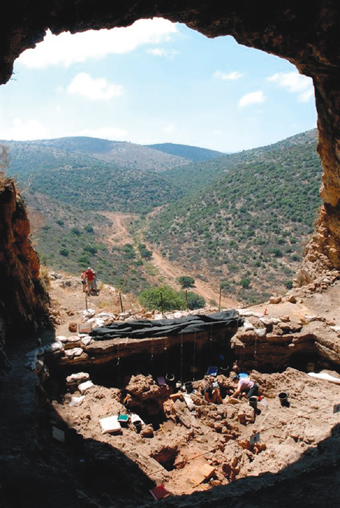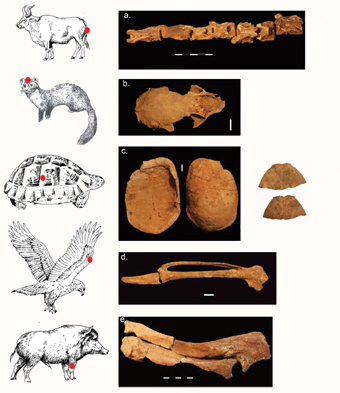An eagle's wing, a cow's tail, turtle shells, furs, a tiger's pelvis and a human foot were found in a cave in the Galilee, in the tomb of the earliest shaman discovered in the Middle East

The change and uncertainty involved in transitional periods give rise to new, and often extraordinary, social and human phenomena. The need to adapt to new conditions and a new environment leads to the creation of complex social structures, the emergence of new cultures, and the growth of leaders.
A team of researchers from the Hebrew University, led by Dr. Lior Grossman, who is currently conducting post-doctoral research in the laboratory of Prof. Uzi Smilansky, in the Department of Physics of Complex Systems at the Weizmann Institute of Science, found evidence that the period of transition to permanent settlements - a period of great importance in the development of human society - It also led to the appearance of the ancient spiritual leader, the shaman, or, more precisely, a shaman. This study, in which Dr. Natalie Monroe from the University of Connecticut also participated, was recently published in the journal "Proceedings of the National Academy of Sciences of the United States of America" (PNAS), and revealed the The earliest evidence of shamanism in our region - a phenomenon that is common to this day in various companies around the world.
Dr. Grossman and the team of archaeologists excavated a 12,000-year-old burial site belonging to the Natufian culture - a society that existed in the last Paleolithic period (11,500 to 15,000 years ago), at the end of which, in the Neolithic period, the first evidence of a new subsistence strategy was found - agriculture. At the burial site, located in the Lower Snail Cave, south of Karmiel, nearly 30 skeletons were found buried in mass graves. One of the skeletons was given a unique tomb - unlike any tomb from the Natufian period or the periods that preceded it. The grave pit was cut in the rock, and its walls and floor were covered with mud and stone slabs. Inside it was found a single skeleton of a small woman, with a curved body, who apparently suffered from lameness. Despite her disability, pathological tests performed by Prof. Anna Belfer-Cohen and Dr. Grossman showed that the woman had reached the age of 45 - an extreme age for that time.
A long line of burial offerings was also found in the grave pit, the most prominent of which is 50 turtle shells. Apart from them, animal parts were found, such as an eagle's wing, a cow's tail, a wild boar's leg, furs, pelvic bones of a tiger - an extremely rare animal in the Natufian culture, as well as a human foot and a fragment of a bowl made of basalt. The researchers believe that these are remains from the burial ceremony, and that the turtle shells were dismantled in a certain location and placed in the grave as part of the ritual activity. Similar objects - such as turtle shells, cow tails, eagle wings and furs - are still used in shamanic ceremonies in Asia, Africa, Europe and America.

"The role of the shaman is to mediate between humans and high spiritual beings, and to serve as a messenger, healer and magician. Their high status in the community is also reflected in the burial customs - which document the powers they had in their lives," says Dr. Grossman. "Although shamanism is a worldwide and cross-cultural phenomenon, only a few archaeological findings confirm its existence, and so far no sign of the appearance of shamans in this period has been found in Southwest Asia. It is not surprising that evidence of their existence was found precisely in the Natufian period, since the deep social and economic changes involved in the transition to agriculture also entailed significant ideological changes." The economic and social revolution that took place during the Natufian period also led to the development of unique burial customs - such as burying the dead near the place of settlement, and with them burial offerings, as demonstrated by the cemetery in the Snail Cave.
Dr. Grossman's interest in the transition period that led to the beginning of agriculture, and her attempts to get to know the period, the people and the structure of society, were also at the center of her doctoral thesis.
Its purpose was to create a tool that would trace the process, and test the various theories that try to explain the causes of the agricultural revolution: population growth, climatic changes and cultural changes. She created a computer model that processes numerical data that describes the size of the population, the climate, the amount of food and more. The model showed that it was changes in the size of the population - and not climate changes - that made the decisive contribution to the unfolding of the agricultural revolution.
Dr. Grossman's mathematical background led her to post-doctoral research in Prof. Smilansky's laboratory at the Weizmann Institute of Science. Here she plans to expand the canvas and purchase additional tools that will assist her in the archaeological research. Here she uses the method developed by Prof. Smilansky - which allows to scan archaeological finds using a XNUMXD camera and obtain accurate data on their characteristics. "Archaeologists who focus on prehistory are trying to decipher a missing piece (puzzle), and the main sources of information at their disposal are the stone, wood and bone tools. The flint finds - tools that were used by man for millions of years - are a key to defining sites and periods," says Dr. Grossman. In a joint study with Oded Smiket, from the department of computer science and applied mathematics at the institute, which was recently published in the Journal of Archaeological Science, the scientists developed an algorithm that automatically determines the best way to place a flint tool for the purpose of measurements, in a way that makes it possible to receive standard numerical data that does not depend on the eye of the beholder , and creating a comprehensive and accurate database. To test the effectiveness of the algorithm, the scientists used it to test a collection of hand stones.
These are drop-like tools that have been used by humans, from Africa to China, for over a million years. Many hypotheses have been put forward as to the use made of these tools: hunting tools, butchering, butchering elephants or perhaps cutting down trees - but there is still great uncertainty. The 90 studied hand stones were collected from three archaeological sites (the age of which ranges from approximately 400,000 to a million years): Nahal Tzihor, Um-Katepa Cave and Mein Baruch. The classification of the findings using the computerized method was similar to that obtained by three groups of scientists who used manual, slower methods, and the resulting division was more unambiguous.
Another study by Dr. Grossman, in collaboration with Dr. Gonen Sharon from the Hebrew University, is aimed at developing a method that will allow archaeologists to determine unequivocally whether the origin of various finds is at the site where they were excavated, or whether they were "transported" to it from another place - for example, swept away by a current of a stream The process of transportation causes changes - erosion, fractures and scars - which can be noticed using the XNUMXD camera. Dr. Grossman uses stones and pebbles, rolls them in a barrel - to simulate the natural weathering processes - and compares the image of the stone before and after the process, in order to describe the differences quantitatively.
Dr. Grossman and Prof. Smilansky say that the use of the XNUMXD camera makes it possible to obtain data that cannot be obtained by other means, such as the volume of the vessels, their center of gravity, different cross-sections, and more. Comparing these data will allow scientists to develop a way to create a "phylogenetic tree", meaning a diagram that maps the level of closeness between different findings. Another goal is the development of an objective and quantitative method for describing features that are considered subjective, such as shape and degree of symmetry.


4 תגובות
It is interesting how they managed to reproduce the appearance of this octopus only from the bones.
To the questioner who asked why a witch and not a shaman - your question will be forwarded to the authors of the article at the Weizmann Institute
Why is a human male referred to as a shaman and a female human given the title of witch?
The site does not need yellow headings.
Those who read the site in advance are looking for topics that are not yellow.
That ancient lady, whose bones we disturbed, can call herself an artist without the slightest hint of the shaman's status.
Why a shaman? This is zoological/pathological.